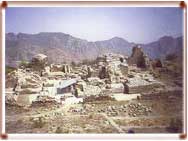Gandhara Buddhist Monuments, Pakistan
© UNESCO 2003
National implementing agency:
Department of Archaeology and Museums, Pakistan
Project duration: Phase I: 1994-1999 / Phase II: 2000-2004
Total project budget: Phase I: US$ 500,000 / Phase II: US$ 499,460
"The Gandhara region is famous for its specific culture born out of the encounter between East and West. From the 3rd century BC to the 7th century AD, Buddhist art and architecture developed in northern Pakistan under the influence of Hellenistic and Irano-Parthian traditions. It is also here that Mahayana Buddhism was born and flourished before reaching China, Korea and Japan through the ancient Silk Roads of Central Asia. Since 1959, Kyoto University has been excavating the central part of Gandhara, notably the Ranigat Site, the importance of which Stein and Foucher pointed out in the 1890's.
Thanks to this project launched in 1994, the large monastery of Ranigat is now ready to receive visitors. The project has enabled the identification of the most appropriate conservation methods for the Site, and these will be applied to other sites having similar problems. In addition, more than 100 historical sites and structural remains of the Gandhara period in this area have been identified and recorded during the lifetime of the project."
(Extract from "Preservation of Tangible Cultural Heritage through the UNESCO/Japanese Funds-in-Trust" p.10)
Links:
Latest Publication on the International Cooperation through the UNESCO/Japanese Funds-in-Trust (
pdf, 2.91MB)
Second publication (2003) concerning the Japanese Funds-in-Trust Preservation of Cultural Heritage (
pdf, 2.29MB)
First publication concerning the Japanese Funds-in-Trust Preservation of Cultural Heritage (1998) (
pdf, 5.92MB)
Back to : The Japanese Funds-in-trust for the Preservation of World Cultural Heritage
Legal Matters | About Accessibility | Privacy Policy
Copyright : 2013 Permanent Delegation of Japan to UNESCO
